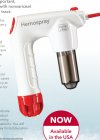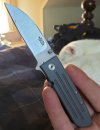Nathan the Machinist
KnifeMaker / Machinist / Evil Genius
Moderator
Knifemaker / Craftsman / Service Provider
- Joined
- Feb 13, 2007
- Messages
- 15,650
I did the plastic product design on the Cook Hemospray a few years ago.

Not that complicated looking, but you know how complicated the details get on an injection molded product. When it was done I had one of the engineers on the client side complain to me because I'd modeled it using surfaces and their best practices said I should have done the job with solid modeling so that anyone could easily edit it. He thought that a plastic product design should be something that anyone could easily edit. Never mind the fact you couldn't really duplicate the industrial design the stylist had created with just solids. The limitations of pure solid modeling would then dictate a somewhat crude and simplified design. This guy thought it was reasonable that their product should be dumbed down until it was something that could be edited by anyone and modeled without surfacing. Because their best practices said so. Can you imagine what the world would look like if none of the plastic products were modeled with surfacing? I just shake my head.

Not that complicated looking, but you know how complicated the details get on an injection molded product. When it was done I had one of the engineers on the client side complain to me because I'd modeled it using surfaces and their best practices said I should have done the job with solid modeling so that anyone could easily edit it. He thought that a plastic product design should be something that anyone could easily edit. Never mind the fact you couldn't really duplicate the industrial design the stylist had created with just solids. The limitations of pure solid modeling would then dictate a somewhat crude and simplified design. This guy thought it was reasonable that their product should be dumbed down until it was something that could be edited by anyone and modeled without surfacing. Because their best practices said so. Can you imagine what the world would look like if none of the plastic products were modeled with surfacing? I just shake my head.


